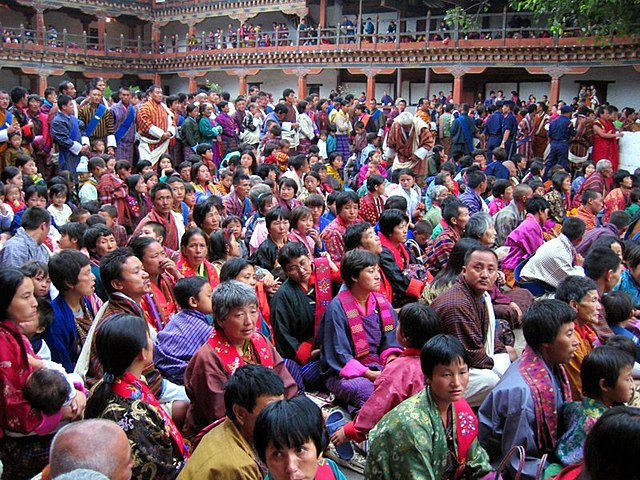Top Qs
Timeline
Chat
Perspective
Demographics of Bhutan
From Wikipedia, the free encyclopedia
Remove ads
This is a demography of the population of Bhutan including population density, ethnicity, education level, health of the populace, economic status, religious affiliations and other aspects of the population.

The Royal Government of Bhutan listed the country's population as 752,700 in 2003.[needs update][9]
The Bhutanese numbers can be reconstructed from their 9th Five Year Plan documents,[10] which lists the exact number of households in each gewog. If the Bhutanese refugee advocate groups are correct, a spot check of a southern gewog should show a massive under-reporting of population.[citation needed]
The CIA World Fact book number has since been adjusted with a note of former inconsistencies, and attributes the difference to the government not including the "first modern census of Bhutan, conducted in 2005".[9] In the 1970s Bhutan was one of the most isolated countries in the world and nobody knew how many people lived there since no census had ever been taken.
Remove ads
Demographic statistics
The following demographic statistics are from the CIA World Factbook, unless otherwise indicated.
Population
Summarize
Perspective
- 708,427 (July 2011 est.)
- 716,896 (July 2012 est.)
- 750,125 (July 2016 est.)[11]
Population by Sex and Age Group
Population Estimates by Sex and Age Group (01.VII.2013) (Data refer to projected figures based on the Population and Housing Census 2005 (district projection)):[12]
Population by Sex and Age Group (Census 30.V.2017) (Excluding 8408 non-Bhutanese/tourists found in hotels on the census reference day.):[13]
Population Estimates by Sex and Age Group (30.VII.2020) (Estimates or projections based on the 2017 Population Census.):[13]
Median age
- Total: 27.2 years
- Male: 27.7 years
- Female: 26.6 years (2016 est.[14])
Urbanization[15]
- urban population: 38.6% of total population (2015)
- rate of urbanization: 3.69% annual rate of change (2010-15 est.)
Remove ads
Vital statistics
Summarize
Perspective
UN estimates
Below is a table of Bhutan vital statistics since 1950 published by the United Nations Department of Economic and Social Affairs.[16]
Registered births and deaths

Life expectancy at birth
- Total population: 70.2 years
- Male: 68.8 years
- Female: 71.7 years (2017[11] est.)
Life expectancy at birth is 70.2 years, which is an increase from 66.3 years in 2005. Women (71.7 years) live longer than men (68.8).
In 2018, Prime Minister Tshering Tobgay announced that the average life expectancy at birth has surpassed 70.[20]
Remove ads
Ethnic groups
- Ngalop people and Sharchop people (63.0%)
- Lhotsampas (also known as Nepalis) (22.0%)
- Indigenous or migrant ethnic groups (15.0%)
Religions
This section needs expansion. You can help by adding to it. (April 2025) |
Languages
References
External links
Wikiwand - on
Seamless Wikipedia browsing. On steroids.
Remove ads

